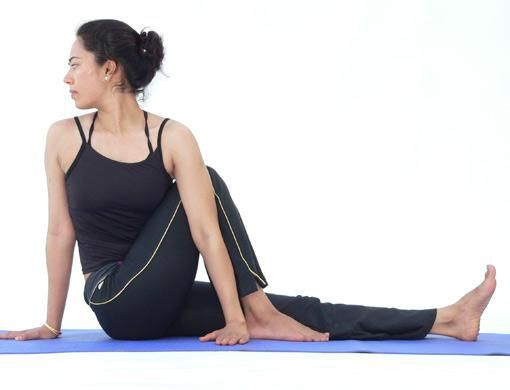The sciatic nerve is the largest nerve in the body. It starts from the sacrum and moves down the back of the legs and on to the toes.
Compression of the sciatic nerve can cause one-sided numbness, tingling or pain in the sacrum, buttock and the back of the legs. The nerve can become compressed due to several reasons, most common of which can be a herniated disk in the lower lumbar spine.
Inflammation, stenosis (narrowing of the spinal canal) and tightening of the piriformis muscles (deep muscles in the buttocks) are other common causes of compression.
Simple solution
The compression and inflammation of sciatica and the pain can be reduced by a mild yoga practice.
Focus on postures that lengthen and align the spine, back bends, postures that stretch the piriformis triangle, abdomen-strengthening poses and inversions. Practise the postures carefully and for short durations.
Avoid any movement that can cause or intensify the pain. Slow, deep yogic breathing will encourage the body to relax and also decrease inflammation and pain. When in pain, yoga asanas should be avoided until the pain has subsided.
Be careful while doing forward-bending and side-bending poses. Before the yoga programme treats your sciatica, you need to understand the main cause of your pain.
Maintain a good posture and move your body correctly throughout the day. Take frequent breaks to breathe, stretch and relax. Rest on your back with your knees bent and avoid sitting for long periods.
— Bharat Thakur is the founder of Bharat Thakur's Artistic Yoga. For questions on yoga, write to dubai.artisticyoga@gmail.com. For information, log on to www.bharatthakur.com
Pranayama for sciatica (Breathing exercises)
Nadi shodhana pranayama
(Alternate-nostril breathing)
Sit in padmasana. (Explained below.)
Bend one leg, place ankle on the opposite thigh.
Bend the other leg and place the ankle on the thigh of the bent leg. Place the hands on the knees.
Close your eyes and practise deep breathing.
Close right nostril with thumb, place ring finger between eyebrows and inhale to the count of five.
Close left nostril with ring finger and place the thumb between the eyebrows. Hold the breath till the count of ten.
Lift the thumb and exhale slowly through the right nostril to the count of ten. Now, breathe in again through right nostril to the count of five.
Close right nostril with the thumb and hold your breath till the count of ten. Place ring finger between eyebrows and exhale through left nostril while counting to ten.
Repeat the complete cycle for 2 to 5 minutes.
Asanas for sciatica (Postures)
Tadasana
(Palm tree pose)
Stand with the feet together or about 10cm apart. Keep arms by the sides.
Now, raise the arms over the head.
Interlock the fingers and turn the palms upward.
Inhale and stretch the arms, shoulders and chest upward.
Repeat 5 to 10 times.
Parvatasana
(Mountain pose)
Bend over on the hands and knees, with palms positioned below the shoulders, fingers facing forward, knees together and toes tucked in.
Exhale, push back your arms and raise the hips.
Bring chin towards the chest and look towards the navel.
Try to keep the heels flat on the floor.
Hold for 10 to 30 seconds, breathing normally.
Resume start position.
Caution: People suffering from high blood pressure, heart conditions, slipped disc and a weak spine should not practise these asanas.
Ushtrasana
(Camel pose)
Sit in vajrasana.
Stand on the knees with the arms by the sides.
Bend backwards, slowly reach for the right heel with the right hand and then hold the left heel with the left hand. Do not strain.
Push the abdomen forward, trying to keep the thighs vertical and bend the head and spine backward, as far as possible.
The weight of the body should be evenly supported by the legs and arms. Return to the start position by slowly releasing the heels, one at a time.
Repeat three times and hold for 15 to 30 seconds.
Caution: People with severe back ailments should avoid this asana.
Bhujangasana
(Cobra pose)
Lie on your stomach with your chin touching the ground.
Place your palms next to your chest.
Raise your chest by arching your back. Look upwards.
Maintain this posture for 30 seconds.
Avoid jerky movements while performing this asana.
Caution: People suffering from backaches should perform this asana only under expert guidance.
Sarvangasana
(Shoulder stand)
Lie flat on back, arms by the side.
Slowly raise the legs to a 90 degree position.
Lift the hips and support them with hands. Gently push the chest forward so that it presses against the chin.
Tighten your buttocks and try to hold your legs in the air as straight as possible.
Hold for 10 to 30 seconds. If there is any discomfort, stop doing the asana immediately .
Breathe normally.
Caution: This asana should not be practised by people suffering from enlarged thyroid, liver or spleen. Also those with cervical spondylosis, slipped disc, weak blood vessels in the eyes, high blood pressure or heart ailments should stay away from this asana. Menstruating women or those in advanced stages of pregnancy should also avoid this exercise.
Meru vakrasana
(Sitting spinal twist)
Sit with the legs stretched out and back straight.
Bend the right knee.
Bring the left hand to the outer side of the right leg, twisting the trunk.
Place the left hand on the floor near the right ankle.
Place the right hand behind the back on the floor for support.
Turn the back and look over the right shoulder.
Caution: People with severe back problems, ulcer and hernia should avoid this posture.












